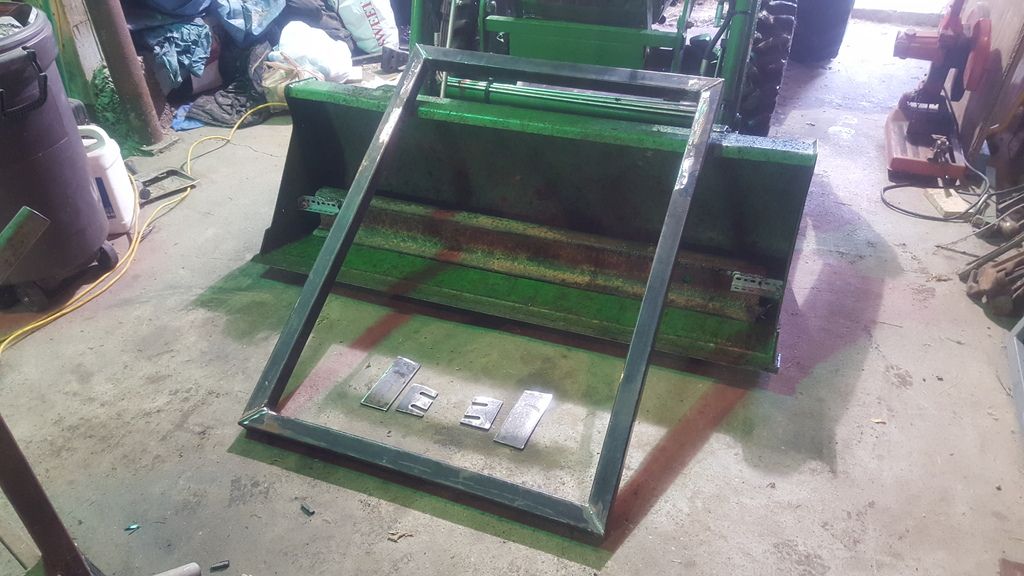dieselcrawler
Elite Member
I deal with slopes every time I'm on my tractors, like this, and worse. This is about 20°, I've side hilled up to about 30°-35°, and I d@mn sure don't like it. But the tractor can do it, and I go as slow as I can in those situations. I can do 45° going up and down, but that's as far as traction will let me go.

I've taken steps to make life safer, and reduce the risk of a rollover. All 4 tires are loaded. Rears are spaced out 4.5" on each side beyond the widest factory settings, with spacers I built.

I also added front ballast, with a 5' cutter on the back, and no loader, the front wheels won't stay on the ground. So I always have the loader on... in addition, I carry a 5' long piece of railroad track in the bucket, for even better front wheel traction. It has tabs welded to it, and a bolt into the bucket side on either end to keep it in place. Last thing you want is that much weight moving around. It's visible here, behind the start of the next step, a full cage ROPS/ FOPS.

I realize that adding weight up high makes a rollover more likely, but in this case, I'll take the payoff of added protection in a rollover and it helps keep brush out of my face in the woods. The factory ROPS was not modified in any way, and I trust my fabrication skills to have added protection due to triangulation of the tubing, and not just added more stuff that might injure me.

What I can't post a picture of is years of offroad driving experience. The seat-of-the-pants-o-meter is calibrated pretty good, and having been on a tractor since I was 8 years old, in trucks since 10, mud trucks and other offroad play toys since my teens, the situational awareness that let's you know when the uphill side is getting 'light', helps keep the rubber on the dirt. Having wheels in the air and dirt coming in the window when the ol truck is laying on its side teaches you something... as does catching a 4wheeler (atv) with your face (it hurts, eating thru a straw for 7 weeks isn't fun). All the advice in the world can't replace that 'knowing' that things are still ok, or yikes, that's sketchy.
Good luck, and be safe. Hope my input was helpful.

I've taken steps to make life safer, and reduce the risk of a rollover. All 4 tires are loaded. Rears are spaced out 4.5" on each side beyond the widest factory settings, with spacers I built.

I also added front ballast, with a 5' cutter on the back, and no loader, the front wheels won't stay on the ground. So I always have the loader on... in addition, I carry a 5' long piece of railroad track in the bucket, for even better front wheel traction. It has tabs welded to it, and a bolt into the bucket side on either end to keep it in place. Last thing you want is that much weight moving around. It's visible here, behind the start of the next step, a full cage ROPS/ FOPS.

I realize that adding weight up high makes a rollover more likely, but in this case, I'll take the payoff of added protection in a rollover and it helps keep brush out of my face in the woods. The factory ROPS was not modified in any way, and I trust my fabrication skills to have added protection due to triangulation of the tubing, and not just added more stuff that might injure me.

What I can't post a picture of is years of offroad driving experience. The seat-of-the-pants-o-meter is calibrated pretty good, and having been on a tractor since I was 8 years old, in trucks since 10, mud trucks and other offroad play toys since my teens, the situational awareness that let's you know when the uphill side is getting 'light', helps keep the rubber on the dirt. Having wheels in the air and dirt coming in the window when the ol truck is laying on its side teaches you something... as does catching a 4wheeler (atv) with your face (it hurts, eating thru a straw for 7 weeks isn't fun). All the advice in the world can't replace that 'knowing' that things are still ok, or yikes, that's sketchy.
Good luck, and be safe. Hope my input was helpful.
